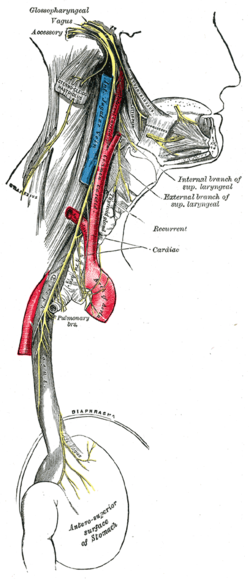
Back عصب مبهم Arabic Azan sinir Azerbaijani Блуждаещ нерв Bulgarian Nerv lutalac BS Nervi vague Catalan Bloudivý nerv Czech Nervus vagus Danish Nervus vagus German Πνευμονογαστρικό νεύρο Greek Vago Esperanto
| Vagus nerve | |
|---|---|
 Plan of the upper portions of the glossopharyngeal, vagus, and accessory nerves. | |
 Course and distribution of the glossopharyngeal, vagus, and accessory nerves. | |
| Details | |
| Innervates | Levator veli palatini, salpingopharyngeus, palatoglossus, palatopharyngeus, superior pharyngeal constrictor, middle pharyngeal constrictor, inferior pharyngeal constrictor, viscera |
| Identifiers | |
| Latin | nervus vagus |
| MeSH | D014630 |
| NeuroNames | 702 |
| TA98 | A14.2.01.153 |
| TA2 | 6332 |
| FMA | 5731 |
| Anatomical terms of neuroanatomy | |
The vagus nerve, also known as the tenth cranial nerve (CN X), plays a crucial role in the autonomic nervous system. This nerve carries both sensory and motor fibers and serves as a major pathway that connects the brain to various organs, including the heart, lungs, and digestive tract. As a key part of the parasympathetic nervous system, the vagus nerve helps regulate essential functions like heart rate, breathing, and digestion. By controlling these processes, the vagus nerve contributes to the body's "rest and digest" response, helping to calm the body after stress, lower heart rate, improve digestion, and maintain homeostasis.
The vagus nerve consists of two branches: the right and left vagus nerves. In the neck, the right vagus nerve contains approximately 105,000 fibers, while the left vagus nerve has about 87,000 fibers, according to one source. However, other sources report slightly different figures, with around 25,000 fibers in the right vagus nerve and 23,000 fibers in the left.[1][2]
The vagus nerve is the longest nerve of the autonomic nervous system in the human body, consisting of both sensory and motor fibers. The sensory fibers originate from the jugular and nodose ganglion, while the motor fibers are derived from neurons in the dorsal motor nucleus of the vagus and the nucleus ambiguus.[3] Historically, the vagus nerve was also known as the pneumogastric nerve, reflecting its role in regulating both the lungs and digestive system.
- ^ Hoffman, Henry Harland; Schnitzlein, Harold Norman (March 1961). "The numbers of nerve fibers in the vagus nerve of man". The Anatomical Record. 139 (3): 429–435. doi:10.1002/ar.1091390312. ISSN 0003-276X.
- ^ Neuhuber, Winfried L.; Berthoud, Hans-Rudolf (1 October 2022). "Functional anatomy of the vagus system: How does the polyvagal theory comply?". Biological Psychology. 174: 108425. doi:10.1016/j.biopsycho.2022.108425. ISSN 0301-0511.
- ^ Walker HK (1990). "Cranial Nerve XI: The Spinal Accessory Nerve". Clinical Methods: The History, Physical, and Laboratory Examinations (3rd ed.). Butterworths. ISBN 9780409900774. PMID 21250228. Retrieved 30 May 2019 – via NCBI Bookshelf.